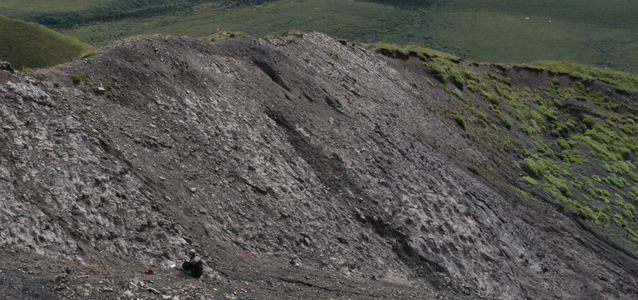
NPS photo
Prior to June 27, 2005, there was no known dinosaur footprint record in Denali. Then everything changed. The find of a fossil theropod track in the Cantwell Formation near Igloo Creek—the first evidence of dinosaurs found in Denali and Interior Alaska—has prompted intensified searches and more discoveries.
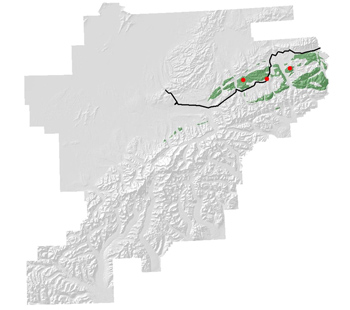
NPS photo
Collaborative efforts
In addition to searches by former park geologist, Phil Brease, along with interns, students, and workshop participants, three paleontology research projects have scoured Denali’s lower Cantwell Formation.
Dr. Anthony Fiorillo, dinosaur expert and Curator of Earth Sciences at the Museum of Nature and Science, Dallas, has returned each year to search new areas (e.g., Fang Mountain) and scrutinize further such locales as Double Mountain, Cabin Peak, and the Tattler drainage. He was accompanied in 2007 and 2008 by Dr. Steve Hasiotis (University of Kansas) and Yoshi Kobayashi (Japan’s Hokkaido University Museum). They provided their expertise on trace fossils (e.g., tracks, feeding marks, burrows, and fossil droppings) to learn about the anatomy and behavior of the animals that left these traces.
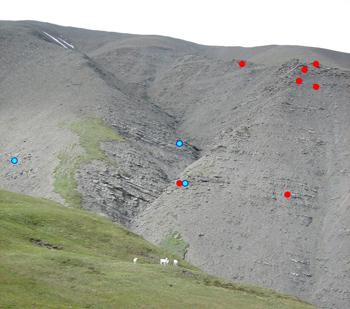
NPS photo
In 2007, Dr. David Sunderlin, a paleobotanist from Lafayette College, traversed Mount Sheldon for fossil plant material, in order to make inferences about paleoclimates. And in 2007 and 2008, Dr. Paul McCarthy, of University of Alaska Fairbanks, and graduate student Susi Tomsich, detailed the stratigraphy of the Cantwell Formation near Sable Mountain and in the Tattler Creek drainage.
After four wildly successful seasons of fossil discovery (2005 to 2008), it is indisputable that the Cantwell outcrops in Denali have preserved a wide array of plants and animals in several depositional environments (shallow lakes, rivers, floodplains, and uplands). More than a thousand feet of stratigraphy (rock layers) have been measured, described, and documented in several areas of the lower Cantwell. Collectively, the fossil finds and stratigraphic analyses provide first glimpses at the paleoecology of the Late Cretaceous (65 to 70 million years ago).
Dinosaurs and "dance floors"
As of 2008, the dinosaur record at Denali includes dozens and dozens of tracks of four different-sized theropods (meat-eaters), tracks of a hadrosaur (duck-billed plant eater) and its young, tracks of possible ceratopsians (beaked plant eater), and an impression of a pterosaur manus (hand).
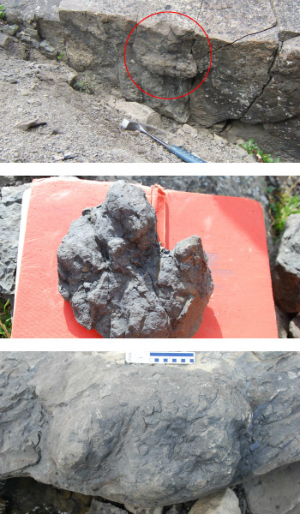
Photo by Anthony Fiorillo
Of the hundreds of Cantwell fossil sites discovered so far, some contain a single track while others contain dozens or hundreds. Researchers have come to call those rock strata with numerous tracks on the same surface “dance floors,” even though these surfaces have been uplifted or shifted to be non-horizontal.
More than dinosaurs
The catalog of fossil finds includes snail traces, worm burrows, fin traces of big and little fish, bird tracks, beak probing marks, a possible feather trace, several suspected small mammal trackways, some possible claw marks, and other trace fossil features. Both Cabin Peak and Double Mountain areas have rich records of fossil invertebrates, finds unparalleled since the mid-1800s. In particular, trace fossil fish known as Undichna are abundant.
Reconstructing Cretaceous ecosystems
Fossil ferns and horsetails (Equisetum) indicate riparian or floodplain conditions; other plant finds (Metasequoia leaves, spruce cones, and stems or leaves of deciduous shrubs and trees) are clues to dryer, more stable upland conditions. Periods of gradual sediment deposition and fossil formation may have been interrupted or disturbed by floods, rapidly-changing river channels, ancient debris flows, or alluvial fan deposits. Paleo-soil horizons with partially or fully developed roots or plants demonstrate frequent flash floods and new deposits.
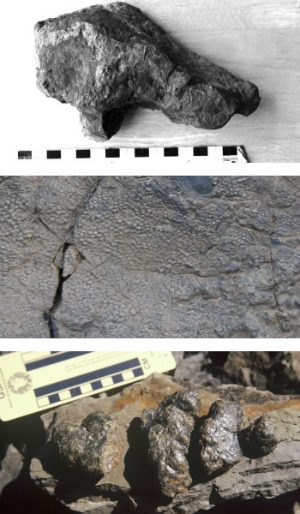
Photo by Anthony Fiorillo
All this fossil evidence is being pieced together to reconstruct the nature of paleo-ecosystems from 70-million years ago. A full reconstruction is not yet completed, but the diversity of fossils has Fiorillo asserting that Denali, and especially the Cabin Peak area, is perhaps second only to Dinosaur National Monument in terms of national park importance for the study of dinosaurs and their associated ecosystems. It truly can be said that Denali is a premier park for protecting entire ecosystems— today’s and ancient Cretaceous ones too.
Last updated: October 26, 2021
